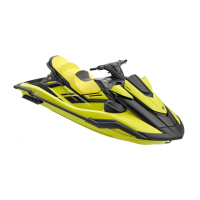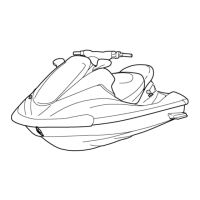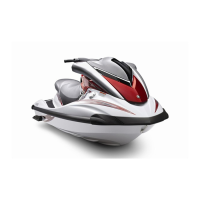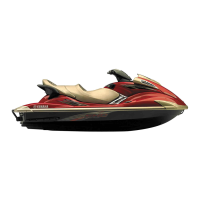Do you have a question about the Yamaha FX HO 2019 and is the answer not in the manual?
Confirms compliance with EU Directive 2013/53/EU for personal watercraft.
Provides details on the watercraft's identification and design category.
Details the engine specifications, including fuel type and combustion cycle.
Outlines the essential requirements for construction and emissions.
Welcome message and advice on using the manual for proper operation and maintenance.
Details on PRI-ID, CIN, and engine serial numbers for parts ordering and identification.
Instructions to read labels before use and consult a dealer for questions.
Highlights critical safety warnings found on the watercraft.
Information on other labels, including emissions and capacity.
Specifies age, supervision, and passenger limits for safe operation.
Guidance on safe operating speeds, distances, and maneuvers.
Mandatory items like PFDs, protective clothing, and recommended gear.
Lists essential items like sound signaling devices, visual distress signals, and watches.
Alerts about exhaust fumes, hot engine parts, and magnetic force interference.
Explains jet thrust steering, off-throttle steering (OTS), and neutral operation.
Safety considerations and best practices for towing skiers and wakeboarders.
Emphasizes legal compliance and safe operation according to waterway regulations.
Promotes respectful operation towards others, nature, and proper maintenance.
Definitions of terms like Trolling speed, Planing speed, Bow, Stern, and Port.
Diagrams identifying exterior and interior components of the watercraft.
Overview of controls like the multifunction information center and its settings.
Details on locking/unlocking the watercraft to prevent unauthorized use.
How to use the red button to stop the engine immediately.
Explanation of the lanyard system for engine shut-off during emergencies.
Instructions for starting the engine and precautions for land operation.
Operation of the lever that controls engine speed and throttle.
Function of the lever for controlling reverse and deceleration.
How to steer the watercraft using the handlebars and jet thrust.
Procedure for adjusting handlebar position using the tilt lever.
Location and function of the outlet for monitoring engine cooling system.
How to drain water from the fuel system to prevent engine damage.
Overview of core operational functions like shift and trim systems.
Instructions for shifting between forward, neutral, and reverse.
Adjusting the jet thrust nozzle angle to optimize performance.
Explanation of different operating modes available on the watercraft.
Function for temporarily increasing engine speed for smoother reverse maneuvers.
Enables low-speed forward or reverse movement using the reverse gate.
Maintains a fixed engine speed for low-speed operation in no-wake zones.
Sets maximum speed and acceleration for stable towing and novice operators.
Maintains a desired engine speed within a fixed range for consistent operation.
Overview of the touch screen display for various watercraft information and settings.
Description of physical buttons like MENU SCROLL and ALARM MUTE.
Guidelines for interacting with the touch screen interface.
Explanation of indicators like trim setting, voltmeter, tachometer, and fuel level.
Details on the main display showing speedometer and operation mode indicators.
How to access and view trip information and fuel consumption data.
Displays average fuel consumption, total fuel used, and consumption per hour.
Options for changing PIN, display brightness, color, units, and language.
Overview of all possible warnings, including engine, fuel, and battery alerts.
Indicates low fuel level and advises refueling.
Alerts for low or high battery voltage, recommending dealer service.
Indicates sensor malfunction or short circuit, requiring immediate attention.
Alerts when engine temperature rises significantly, requiring immediate action.
Indicates low oil pressure, potentially limiting engine speed and requiring checks.
Covers communication errors and exceeding maintenance intervals.
Instructions for removing and installing the front and rear seats.
Usage of handgrips for boarding and stability, with safety warnings.
How to use the reboarding grip and step for assisted re-boarding from water.
Purpose of the bow eye for towing, mooring, and transport.
Function of stern eyes for securing the watercraft during transport or mooring.
Use of cleats for attaching ski ropes, with safety warnings against lifting.
Operation of pull-up cleats for mooring, with safety warnings.
General information about the watercraft's storage compartments.
Details on accessing and capacity of the bow storage compartment.
Instructions for opening, closing, and draining the glove compartment.
Location and capacity of the stern storage compartment.
Location and usage of the beverage holder, with precautions.
Instructions for opening, closing, and capacity of the removable compartment.
Procedure for installing a fire extinguisher in its holder.
Location of a bracket for installing optional accessories.
Specifies recommended fuel type, octane rating, and handling precautions.
Guidance on using gasohol blends with ethanol or methanol.
Details on the fuel tank's total capacity and refueling procedure.
Specifies recommended oil types, grades, and handling precautions.
Step-by-step guide on how to check the engine oil level.
Procedures for draining bilge water on land and on water.
Instructions for securely tying down the watercraft for transport.
Essential steps for breaking in the engine to ensure longevity and performance.
Introduction to pre-launch checks performed on land before operation.
Checking the engine compartment for damage and fuel leaks.
Inspecting the fuel system for leaks, damage, and proper cap seal.
Ensuring no water has collected in the water separator.
Checking the exterior of the engine unit for any damage or issues.
Verifying the engine oil level is between the minimum and maximum marks.
Confirming there is no bilge water in the engine compartment.
Checking battery terminals, connections, and electrolyte level.
Ensuring smooth and unrestricted operation of the steering system.
Verifying the tilt steering system operates smoothly and handlebars are locked.
Ensuring the RiDE lever operates smoothly and returns to its closed position.
Confirming smooth operation of the throttle lever and its return function.
Verifying the proper operation of the Yamaha Security System.
Inspecting the engine shut-off cord (lanyard) for damage.
Testing the operation of start, stop, and shut-off switches.
Checking the electric trim system's responsiveness and indicator changes.
Ensuring storage compartments are undamaged and free of water.
Verifying the fire extinguisher holder, cover, band, and extinguisher condition.
Confirming that required safety equipment is on board.
Inspecting the hull and deck for any damage or problems.
Ensuring the jet intake is not damaged or clogged with debris.
Checking the jet thrust nozzle and reverse gate for damage or issues.
Inspecting stern drain plugs and O-rings for damage and proper installation.
Ensuring the hood is securely closed before operation.
Introduction to post-launch checks performed in the water with the engine running.
Verifying water discharge from the pilot outlet to confirm cooling system operation.
Ensuring the multifunction information center operates correctly.
Checking that the watercraft moves correctly according to the displayed shift indicator.
Confirming the engine idling speed is within the specified range.
General advice on becoming familiar with controls before operating.
Tips on learning basic techniques and understanding the watercraft's operation.
Emphasizes performing pre-operation checks and understanding local laws.
Correct posture for the operator and passengers.
Procedure and safety precautions for launching from a trailer or shore.
Step-by-step guide to starting the engine in the water, including safety warnings.
How to stop the engine using the stop switch, with steering warnings.
Procedure for securing the watercraft when leaving it unattended.
Basic forward operation using the throttle lever and shift indicator.
Techniques for steering and turning, emphasizing throttle control.
Explanation of stopping mechanisms and distances, emphasizing no brakes.
How to operate in reverse and neutral, including speed limitations.
Safety precautions and procedures for boarding from the water.
Step-by-step guide for boarding the watercraft by a single person.
Instructions for boarding with passengers, ensuring balance and safety.
Safety guidelines for commencing movement after boarding.
Procedure for launching and starting off when using a trailer.
Steps for boarding and getting underway from a dock.
Guidance on safely beaching and docking the watercraft.
Advice for operating in areas with thick weed growth to prevent clogging.
Procedure for discharging residual water from cooling passages after use.
General advice on cleaning and storing the watercraft after use.
Detailed steps for flushing cooling passages to prevent clogging.
Instructions for washing, drying, and protecting the hull and components.
Guidelines for removing, storing, and maintaining the watercraft battery.
Procedures for inspecting battery case, terminals, and breather hose.
How to check and maintain the electrolyte level using distilled water.
Ensuring battery bands are undamaged and properly secured.
Preventive maintenance procedures for storing the watercraft for extended periods.
Recommendations for lubricating moving parts with water-resistant grease.
Advice on applying rust inhibitors to metallic parts and engine components.
Importance of periodic checks and lubrication for safety and efficiency.
Information about the included tool kit and its storage.
Step-by-step guide for removing and reinstalling the engine cover.
Schedule of recommended maintenance tasks and service intervals.
Recommendations and precautions for changing engine oil and filter.
Guide to diagnosing and resolving common watercraft issues.
A table listing common problems, possible causes, remedies, and page references.
Instructions for handling critical situations like jet intake blockage.
Steps to safely remove weeds or debris from the jet intake and impeller.
Procedure to manually raise the reverse gate if it remains lowered due to malfunction.
Instructions for starting the engine using a booster battery and jumper cables.
Safety precautions and steps for correctly connecting jumper cables.
Guide to identifying and replacing blown fuses with correct amperage.
Safety instructions and procedures for towing a disabled watercraft.
Steps for handling a submerged watercraft, including draining and dealer service.
Yamaha's policy on collecting, using, and disclosing engine performance data.
Confirms compliance with EU Directive 2013/53/EU for personal watercraft.
Provides details on the watercraft's identification and design category.
Details the engine specifications, including fuel type and combustion cycle.
Outlines the essential requirements for construction and emissions.
Welcome message and advice on using the manual for proper operation and maintenance.
Details on PRI-ID, CIN, and engine serial numbers for parts ordering and identification.
Instructions to read labels before use and consult a dealer for questions.
Highlights critical safety warnings found on the watercraft.
Information on other labels, including emissions and capacity.
Specifies age, supervision, and passenger limits for safe operation.
Guidance on safe operating speeds, distances, and maneuvers.
Mandatory items like PFDs, protective clothing, and recommended gear.
Lists essential items like sound signaling devices, visual distress signals, and watches.
Alerts about exhaust fumes, hot engine parts, and magnetic force interference.
Explains jet thrust steering, off-throttle steering (OTS), and neutral operation.
Safety considerations and best practices for towing skiers and wakeboarders.
Emphasizes legal compliance and safe operation according to waterway regulations.
Promotes respectful operation towards others, nature, and proper maintenance.
Definitions of terms like Trolling speed, Planing speed, Bow, Stern, and Port.
Diagrams identifying exterior and interior components of the watercraft.
Overview of controls like the multifunction information center and its settings.
Details on locking/unlocking the watercraft to prevent unauthorized use.
How to use the red button to stop the engine immediately.
Explanation of the lanyard system for engine shut-off during emergencies.
Instructions for starting the engine and precautions for land operation.
Operation of the lever that controls engine speed and throttle.
Function of the lever for controlling reverse and deceleration.
How to steer the watercraft using the handlebars and jet thrust.
Procedure for adjusting handlebar position using the tilt lever.
Location and function of the outlet for monitoring engine cooling system.
How to drain water from the fuel system to prevent engine damage.
Overview of core operational functions like shift and trim systems.
Instructions for shifting between forward, neutral, and reverse.
Adjusting the jet thrust nozzle angle to optimize performance.
Explanation of different operating modes available on the watercraft.
Function for temporarily increasing engine speed for smoother reverse maneuvers.
Enables low-speed forward or reverse movement using the reverse gate.
Maintains a fixed engine speed for low-speed operation in no-wake zones.
Sets maximum speed and acceleration for stable towing and novice operators.
Maintains a desired engine speed within a fixed range for consistent operation.
Overview of the touch screen display for various watercraft information and settings.
Description of physical buttons like MENU SCROLL and ALARM MUTE.
Guidelines for interacting with the touch screen interface.
Explanation of indicators like trim setting, voltmeter, tachometer, and fuel level.
Details on the main display showing speedometer and operation mode indicators.
How to access and view trip information and fuel consumption data.
Displays average fuel consumption, total fuel used, and consumption per hour.
Options for changing PIN, display brightness, color, units, and language.
Overview of all possible warnings, including engine, fuel, and battery alerts.
Indicates low fuel level and advises refueling.
Alerts for low or high battery voltage, recommending dealer service.
Indicates sensor malfunction or short circuit, requiring immediate attention.
Alerts when engine temperature rises significantly, requiring immediate action.
Indicates low oil pressure, potentially limiting engine speed and requiring checks.
Covers communication errors and exceeding maintenance intervals.
Instructions for removing and installing the front and rear seats.
Usage of handgrips for boarding and stability, with safety warnings.
How to use the reboarding grip and step for assisted re-boarding from water.
Purpose of the bow eye for towing, mooring, and transport.
Function of stern eyes for securing the watercraft during transport or mooring.
Use of cleats for attaching ski ropes, with safety warnings against lifting.
Operation of pull-up cleats for mooring, with safety warnings.
General information about the watercraft's storage compartments.
Details on accessing and capacity of the bow storage compartment.
Instructions for opening, closing, and draining the glove compartment.
Location and capacity of the stern storage compartment.
Location and usage of the beverage holder, with precautions.
Instructions for opening, closing, and capacity of the removable compartment.
Procedure for installing a fire extinguisher in its holder.
Location of a bracket for installing optional accessories.
Specifies recommended fuel type, octane rating, and handling precautions.
Guidance on using gasohol blends with ethanol or methanol.
Details on the fuel tank's total capacity and refueling procedure.
Specifies recommended oil types, grades, and handling precautions.
Step-by-step guide on how to check the engine oil level.
Procedures for draining bilge water on land and on water.
Instructions for securely tying down the watercraft for transport.
Essential steps for breaking in the engine to ensure longevity and performance.
Introduction to pre-launch checks performed on land before operation.
Checking the engine compartment for damage and fuel leaks.
Inspecting the fuel system for leaks, damage, and proper cap seal.
Ensuring no water has collected in the water separator.
Checking the exterior of the engine unit for any damage or issues.
Verifying the engine oil level is between the minimum and maximum marks.
Confirming there is no bilge water in the engine compartment.
Checking battery terminals, connections, and electrolyte level.
Ensuring smooth and unrestricted operation of the steering system.
Verifying the tilt steering system operates smoothly and handlebars are locked.
Ensuring the RiDE lever operates smoothly and returns to its closed position.
Confirming smooth operation of the throttle lever and its return function.
Verifying the proper operation of the Yamaha Security System.
Inspecting the engine shut-off cord (lanyard) for damage.
Testing the operation of start, stop, and shut-off switches.
Checking the electric trim system's responsiveness and indicator changes.
Ensuring storage compartments are undamaged and free of water.
Verifying the fire extinguisher holder, cover, band, and extinguisher condition.
Confirming that required safety equipment is on board.
Inspecting the hull and deck for any damage or problems.
Ensuring the jet intake is not damaged or clogged with debris.
Checking the jet thrust nozzle and reverse gate for damage or issues.
Inspecting stern drain plugs and O-rings for damage and proper installation.
Ensuring the hood is securely closed before operation.
Introduction to post-launch checks performed in the water with the engine running.
Verifying water discharge from the pilot outlet to confirm cooling system operation.
Ensuring the multifunction information center operates correctly.
Checking that the watercraft moves correctly according to the displayed shift indicator.
Confirming the engine idling speed is within the specified range.
General advice on becoming familiar with controls before operating.
Tips on learning basic techniques and understanding the watercraft's operation.
Emphasizes performing pre-operation checks and understanding local laws.
Correct posture for the operator and passengers.
Procedure and safety precautions for launching from a trailer or shore.
Step-by-step guide to starting the engine in the water, including safety warnings.
How to stop the engine using the stop switch, with steering warnings.
Procedure for securing the watercraft when leaving it unattended.
Basic forward operation using the throttle lever and shift indicator.
Techniques for steering and turning, emphasizing throttle control.
Explanation of stopping mechanisms and distances, emphasizing no brakes.
How to operate in reverse and neutral, including speed limitations.
Safety precautions and procedures for boarding from the water.
Step-by-step guide for boarding the watercraft by a single person.
Instructions for boarding with passengers, ensuring balance and safety.
Safety guidelines for commencing movement after boarding.
Procedure for launching and starting off when using a trailer.
Steps for boarding and getting underway from a dock.
Guidance on safely beaching and docking the watercraft.
Advice for operating in areas with thick weed growth to prevent clogging.
Procedure for discharging residual water from cooling passages after use.
General advice on cleaning and storing the watercraft after use.
Detailed steps for flushing cooling passages to prevent clogging.
Instructions for washing, drying, and protecting the hull and components.
Guidelines for removing, storing, and maintaining the watercraft battery.
Procedures for inspecting battery case, terminals, and breather hose.
How to check and maintain the electrolyte level using distilled water.
Ensuring battery bands are undamaged and properly secured.
Preventive maintenance procedures for storing the watercraft for extended periods.
Recommendations for lubricating moving parts with water-resistant grease.
Advice on applying rust inhibitors to metallic parts and engine components.
Importance of periodic checks and lubrication for safety and efficiency.
Information about the included tool kit and its storage.
Step-by-step guide for removing and reinstalling the engine cover.
Schedule of recommended maintenance tasks and service intervals.
Recommendations and precautions for changing engine oil and filter.
Guide to diagnosing and resolving common watercraft issues.
A table listing common problems, possible causes, remedies, and page references.
Instructions for handling critical situations like jet intake blockage.
Steps to safely remove weeds or debris from the jet intake and impeller.
Procedure to manually raise the reverse gate if it remains lowered due to malfunction.
Instructions for starting the engine using a booster battery and jumper cables.
Safety precautions and steps for correctly connecting jumper cables.
Guide to identifying and replacing blown fuses with correct amperage.
Safety instructions and procedures for towing a disabled watercraft.
Steps for handling a submerged watercraft, including draining and dealer service.
Yamaha's policy on collecting, using, and disclosing engine performance data.











